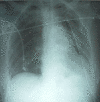Fatal stroke after completion pneumonectomy for torsion of left upper lobe following left lower lobectomy
- PMID: 16968544
- PMCID: PMC1584227
- DOI: 10.1186/1749-8090-1-25
Fatal stroke after completion pneumonectomy for torsion of left upper lobe following left lower lobectomy
Abstract
Background: The lobar torsion after lung surgery is a rare complication with an incidence of 0.09 to 0.4 %. It may occur after twisting of the bronchovascular pedicle of the remaining lobe after lobectomy, usually on the right side. The 180-degree rotation of the pedicle produces an acute obstruction of the lobar bronchus (atelectasis) and of the lobar vessels as well. Without prompt treatment it progresses to lobar ischemia, pulmonary infarction and finally fatal gangrene.
Case presentation: A 62 years old female patient was admitted for surgical treatment of lung cancer. She underwent elective left lower lobectomy for squamous cell carcinoma (pT2 N0). The operation was unremarkable, and the patient was extubated in the operating room. After eight hours the patient established decrease of pO(2) and chest x-ray showed atelectasis of the lower lobe. To establish diagnosis, bronchoscopy was performed, demonstrating obstructed left lobar bronchus. The patient was re-intubated, and admitted to the operating room where reopening of the thoracotomy was performed. Lobar torsion was diagnosed, with the diaphragmatic surface of the upper lobe facing in an anterosuperior orientation. A completion pneumonectomy was performed. At the end of the procedure the patient developed a right pupil dilatation, presumably due to a cerebral embolism. A subsequent brain angio-CT scan established the diagnosis. She died at the intensive care unit 26 days later.
Conclusion: The thoracic surgeon should suspect this rare early postoperative complication after any thoracic operation in every patient with atelectasis of the neighboring lobe. High index of suspicion and prompt diagnosis may prevent catastrophic consequences, such as, infarction or gangrene of the pulmonary lobe. During thoracic operations, especially whenever the lung or lobe hilum is full mobilized, fixation of the remaining lobe may prevent this life threatening complication.
Figures
Similar articles
-
Lobar torsion after pulmonary resection; report of two cases.Ann Thorac Cardiovasc Surg. 2006 Feb;12(1):63-5. Ann Thorac Cardiovasc Surg. 2006. PMID: 16572079
-
Fatal Stroke After Reoperation for Lobar Torsion.Ann Thorac Surg. 2020 Jul;110(1):e51-e53. doi: 10.1016/j.athoracsur.2019.10.066. Epub 2019 Dec 17. Ann Thorac Surg. 2020. PMID: 31862494
-
Uniportal thoracoscopic management of middle lobe torsion after upper lobectomy.Asian Cardiovasc Thorac Ann. 2015 Nov;23(9):1129-31. doi: 10.1177/0218492315592994. Epub 2015 Jun 29. Asian Cardiovasc Thorac Ann. 2015. PMID: 26124430
-
[Torsion of the middle lobe after right upper lobectomy of the lung; report of a case and the review of the Japanese literatures].Kyobu Geka. 2003 Mar;56(3):251-4. Kyobu Geka. 2003. PMID: 12649921 Review. Japanese.
-
Right middle lobe torsion after right upper lobectomy despite pneumopexy in an adult: a case report and review of the literature.J Cardiothorac Surg. 2025 Feb 11;20(1):124. doi: 10.1186/s13019-024-03154-3. J Cardiothorac Surg. 2025. PMID: 39934838 Free PMC article. Review.
Cited by
-
Postlobectomy Early Complications.Thorac Surg Clin. 2015 Aug;25(3):355-64. doi: 10.1016/j.thorsurg.2015.04.003. Epub 2015 Jun 12. Thorac Surg Clin. 2015. PMID: 26210931 Free PMC article. Review.
-
Lung torsion after tracheoesophageal fistula repair in an infant.Korean J Pediatr. 2013 Apr;56(4):186-90. doi: 10.3345/kjp.2013.56.4.186. Epub 2013 Apr 22. Korean J Pediatr. 2013. PMID: 23646058 Free PMC article.
-
Pulmonary torsion after open esophagectomy for esophageal cancer: a case report and review.J Thorac Dis. 2018 Jun;10(6):E462-E468. doi: 10.21037/jtd.2018.05.194. J Thorac Dis. 2018. PMID: 30069406 Free PMC article. No abstract available.
-
Staged surgery for empyema and lung gangrene caused by pseudoaneurysm after radiofrequency ablation.Interact Cardiovasc Thorac Surg. 2021 May 10;32(5):831-833. doi: 10.1093/icvts/ivaa331. Interact Cardiovasc Thorac Surg. 2021. PMID: 33393589 Free PMC article.
-
Rare Postoperative Complication of Esophageal Atresia after Open Thoracotomy Repair in Newborn-Lung Torsion: A Case Report.Pediatr Rep. 2024 Aug 15;16(3):717-723. doi: 10.3390/pediatric16030060. Pediatr Rep. 2024. PMID: 39189294 Free PMC article.
References
-
- Keagy BA, Lores ME, Starek PJ, Murray GF, Lucas CL, Wilcox BR. Elective pulmonary lobectomy: factors associated with morbidity and operative mortality. Ann Thorac Surg. 1985;40:349–52. - PubMed
-
- Wagner R, Nesbitt J. Pulmonary torsion and gangrene. Chest Surg Clin Norht Am. 1992;2:839–852.
-
- Schamaun M. Postoperative pulmonary torsion: report of a case and survey of the literature including spontaneous and posttraumatic torsion. Thorac Cardiovasc Surg. 1994;42:116–21. - PubMed
-
- Velmachos GC, Franhouse J, Ciccolo M. Pulmonary torsion of the right upper lobe after middle lobectomy for a stab wound to the chest. J Trauma. 1998;44:920–922. - PubMed
Publication types
MeSH terms
LinkOut - more resources
Full Text Sources
Medical



